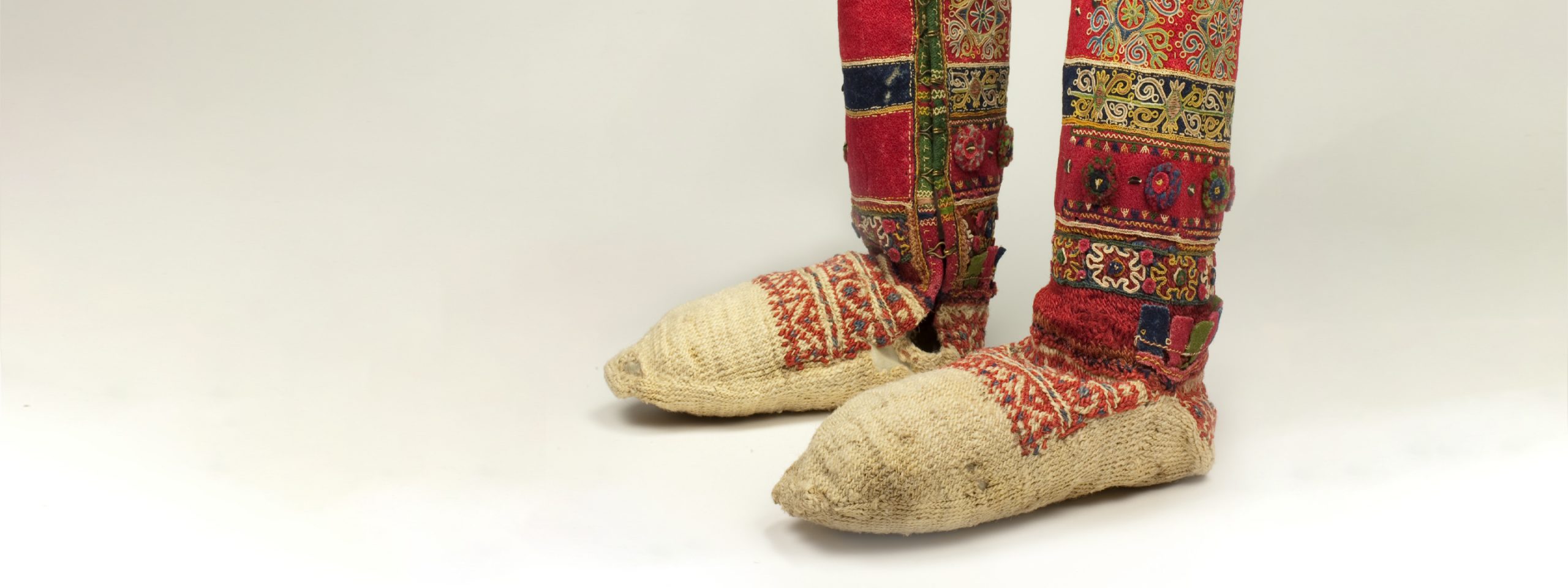
 Explore SOCKS:
Explore SOCKS:
Between You and Your Shoes 
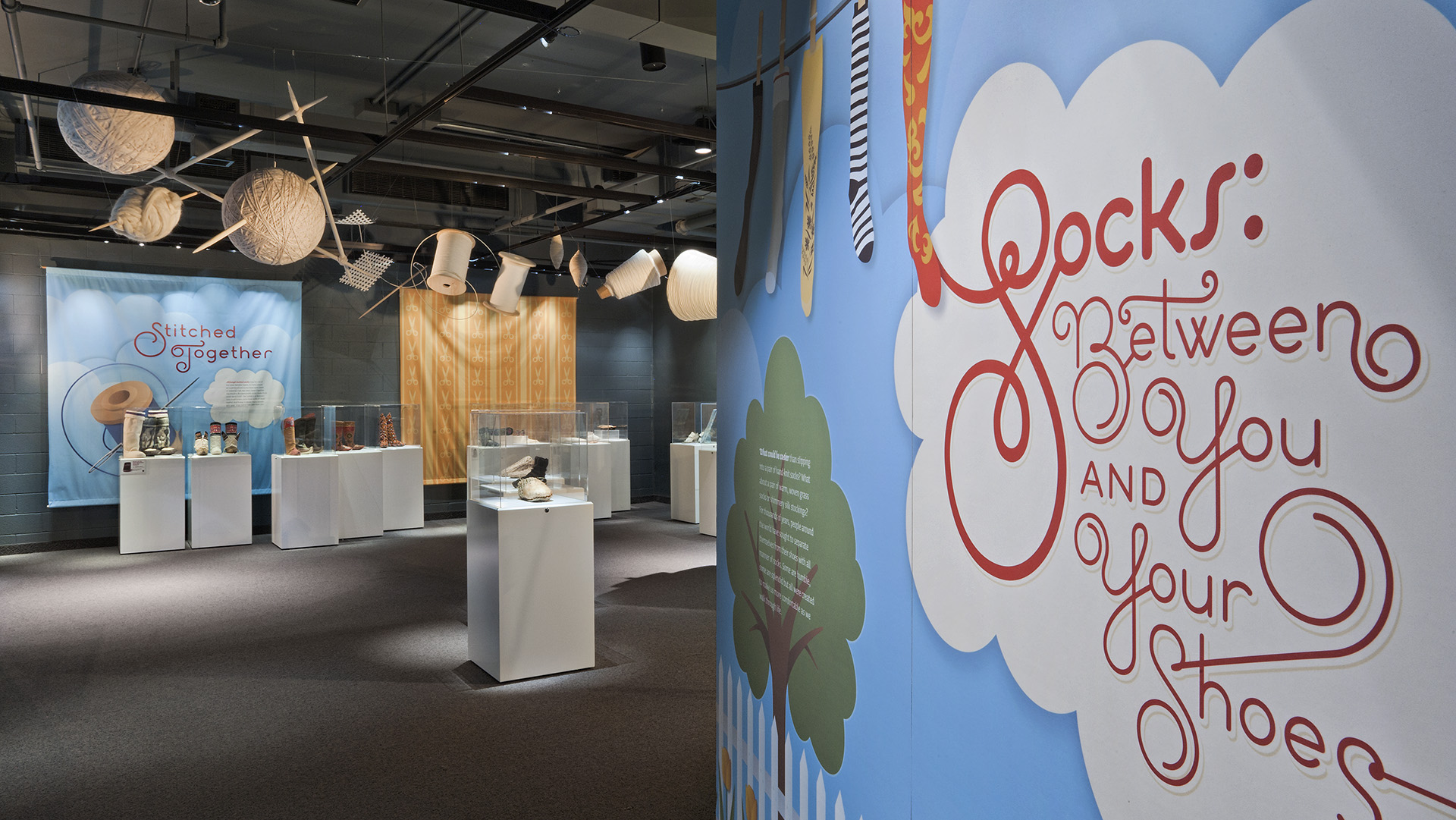 Between You and Your Shoes What could be cosier than slipping into a pair of hand-knit socks? What about pair of warm, woven grass socks or shimmery silk stockings? For thousands of years, people around the world have sought to separate themselves from their shoes with all manner of socks. Some are humble, some are splendid but all were created to make us more comfortable as we walk through life. Next Back
Between You and Your Shoes What could be cosier than slipping into a pair of hand-knit socks? What about pair of warm, woven grass socks or shimmery silk stockings? For thousands of years, people around the world have sought to separate themselves from their shoes with all manner of socks. Some are humble, some are splendid but all were created to make us more comfortable as we walk through life. Next Back 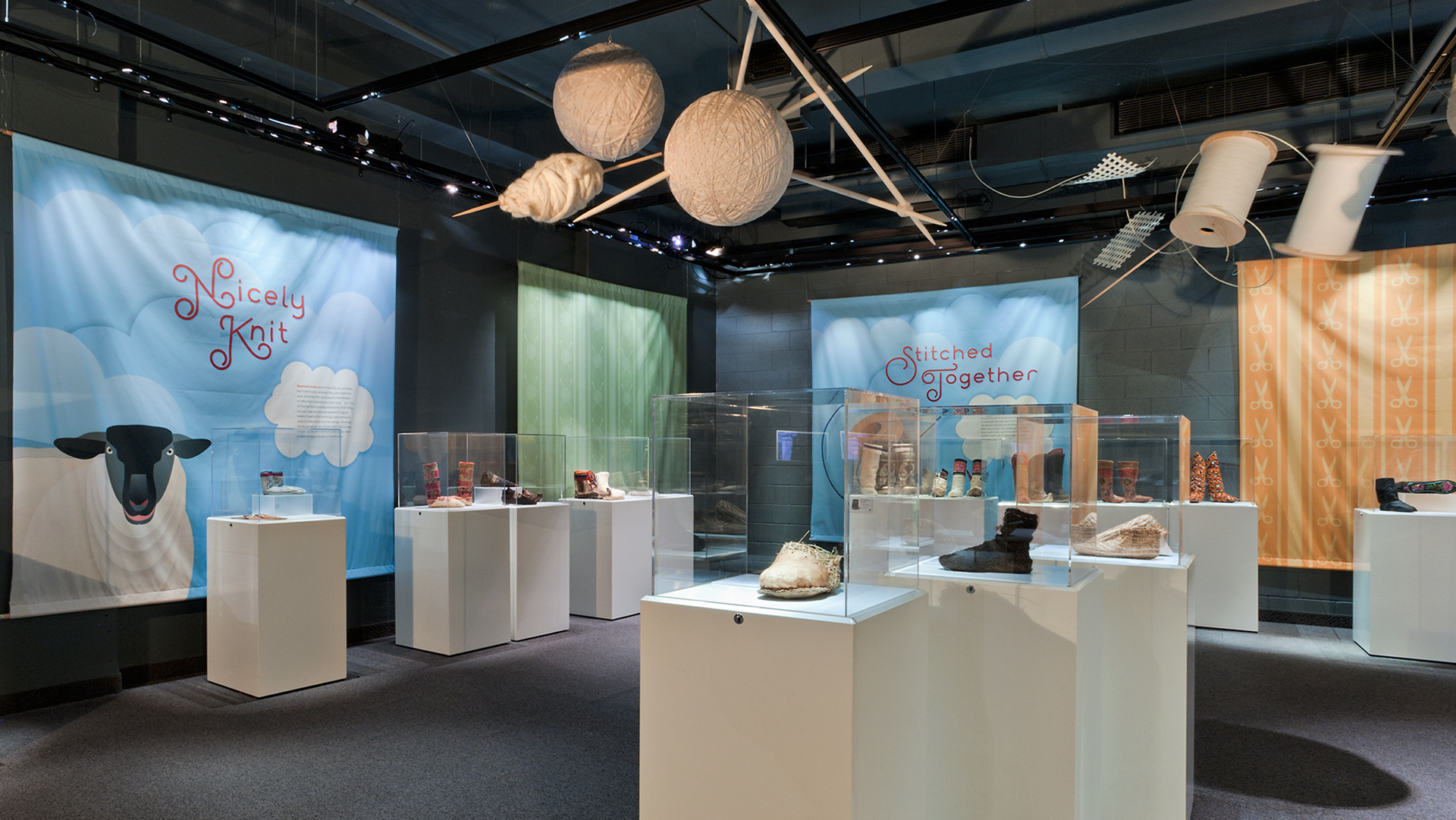 Back Next Socks, a quick history:
Back Next Socks, a quick history: 
 Nicely Knit Knitted socks are very familiar to us today, but historically-speaking they are relatively new. Knitting first developed in the Middle or Near East between 500 and 1200 B.C.E.. One of the earliest surviving examples of knitting is, in fact, a 900 year old sock excavated in Egypt and it seems that knitting was primarily used to make socks and stockings. Knitting slowly spread up into Spain and then across Europe. By the 17th century knit socks were a staple in many people's wardrobes. Next Back
Nicely Knit Knitted socks are very familiar to us today, but historically-speaking they are relatively new. Knitting first developed in the Middle or Near East between 500 and 1200 B.C.E.. One of the earliest surviving examples of knitting is, in fact, a 900 year old sock excavated in Egypt and it seems that knitting was primarily used to make socks and stockings. Knitting slowly spread up into Spain and then across Europe. By the 17th century knit socks were a staple in many people's wardrobes. Next Back  Stitched Together Although knitted socks may be one of the most familiar types of socks, in many places around the world socks have been made of material that has been sewn together. The Ancient Romans wore socks made from sewn woolen cloth, the Uzbek's of Western Asia traditionally wore boots socks of sewn leather and today in Japan many people still wear crisp cotton tabi with their zori. Next Back
Stitched Together Although knitted socks may be one of the most familiar types of socks, in many places around the world socks have been made of material that has been sewn together. The Ancient Romans wore socks made from sewn woolen cloth, the Uzbek's of Western Asia traditionally wore boots socks of sewn leather and today in Japan many people still wear crisp cotton tabi with their zori. Next Back 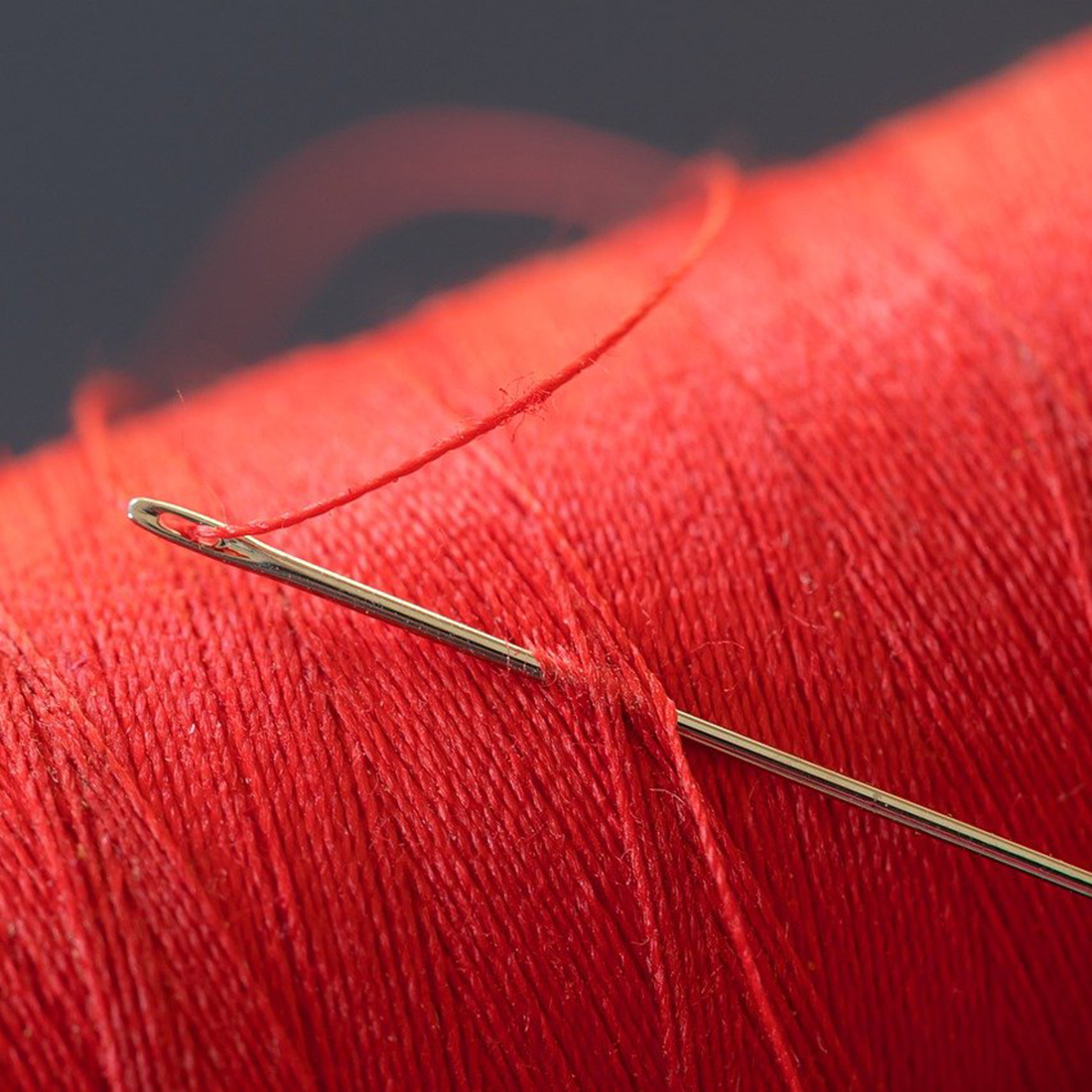

 Factory Fabricated With so many feet in the world it shouldn't be surprising that sock-making was one of the first skills to be mechanized. In the late 16th century, Englishman William Lee invented the stocking frame, a machine that allowed socks to be knit at faster speeds than hand-knitting. Over the centuries, refinements were made to his concept and today all kinds of socks, from thick sports socks to whisper-thin hose are factory fabricated. Next Back
Factory Fabricated With so many feet in the world it shouldn't be surprising that sock-making was one of the first skills to be mechanized. In the late 16th century, Englishman William Lee invented the stocking frame, a machine that allowed socks to be knit at faster speeds than hand-knitting. Over the centuries, refinements were made to his concept and today all kinds of socks, from thick sports socks to whisper-thin hose are factory fabricated. Next Back  Back Next Over the years, socks have been made from a wide variety of materials from grass and hair to leather and silk.
Back Next Over the years, socks have been made from a wide variety of materials from grass and hair to leather and silk. 
 Wool Wool from sheep and goats has a crimped texture and an elastic quality that allows the individual wool fibres to be easily intertwined when spun creating the lofty yarn preferred for sock making. There are many steps that need to be taken before one can make yarn. First the wool needs to be removed from the animal. Sheep-shearing is the most common. Then the wool needs to be cleaned and graded. Carding involves the combing of the wool fibres so that they are aligned together in parallel fashion. Only then can the fibres be spun into yarn or thread.
Wool Wool from sheep and goats has a crimped texture and an elastic quality that allows the individual wool fibres to be easily intertwined when spun creating the lofty yarn preferred for sock making. There are many steps that need to be taken before one can make yarn. First the wool needs to be removed from the animal. Sheep-shearing is the most common. Then the wool needs to be cleaned and graded. Carding involves the combing of the wool fibres so that they are aligned together in parallel fashion. Only then can the fibres be spun into yarn or thread.  Silk Silk cultivation, or sericulture, began over 5500 years ago in China and was a highly guarded secret for centuries making it one of the most valued and desired fibres in history. Silk is made by mulberry silkworm larvae when they prepare their cocoons. They spin their silk in one long continuous thread and it is this thread that is harvested and eventually transformed into textiles of all sorts including socks and stockings. Back Next
Silk Silk cultivation, or sericulture, began over 5500 years ago in China and was a highly guarded secret for centuries making it one of the most valued and desired fibres in history. Silk is made by mulberry silkworm larvae when they prepare their cocoons. They spin their silk in one long continuous thread and it is this thread that is harvested and eventually transformed into textiles of all sorts including socks and stockings. Back Next 
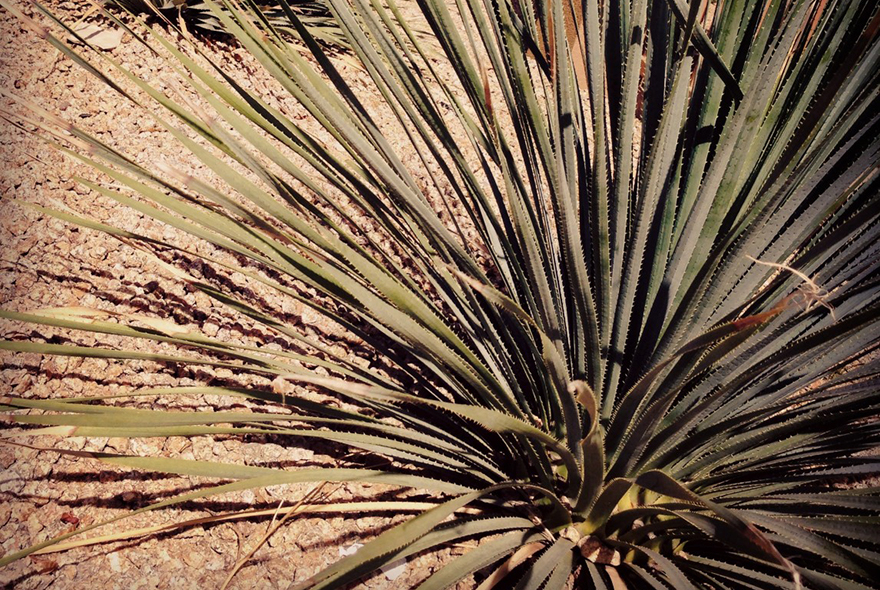 Flax Flax is one of the oldest cultivated plants. Its cultivation dates back at least 30,000 years. Flax is prized for its long, strong fibres that can be spun into thread and then woven into cloth called linen. These long fibres look like blonde hair, this is where we get the term flaxen.
Flax Flax is one of the oldest cultivated plants. Its cultivation dates back at least 30,000 years. Flax is prized for its long, strong fibres that can be spun into thread and then woven into cloth called linen. These long fibres look like blonde hair, this is where we get the term flaxen.  Nylon Nylon is a thermoplastic that was first produced in 1935 by Wallace Caothers at DuPont I the United States. By 1940, silky nylon threads were used to made women's stockings.
Nylon Nylon is a thermoplastic that was first produced in 1935 by Wallace Caothers at DuPont I the United States. By 1940, silky nylon threads were used to made women's stockings.  Cotton Cotton plants produce white fluffy bols that are valued for the long fibres they contain. These fibres, like other fibres used to make textiles, are combed straight and then spun into yarn or thread. Cotton is one of the most common fibres used to make socks today. Back Next
Cotton Cotton plants produce white fluffy bols that are valued for the long fibres they contain. These fibres, like other fibres used to make textiles, are combed straight and then spun into yarn or thread. Cotton is one of the most common fibres used to make socks today. Back Next  Back Next Some are humble, some are splendid but all were created to make us more comfortable as we walk through life.
Back Next Some are humble, some are splendid but all were created to make us more comfortable as we walk through life.  Replica of Ötzi man's shoe, 2002 Have you heard of the Otzi man? In 1991, the well-preserved remains of a man who died 5,300 years ago were found in the Alps between Switzerland and Italy. Not only had his body been preserved, but his clothing including his shoes and "socks" were found. The socks were really bunches of grass that the Ötzi man had stuffed into his shoes. Dr. Petr Hlavacek, a Czech researcher who worked on the Ötzi man's shoes, made this replica for himself to see how well the shoe and grass functioned. After hiking in his replica shoes, Hlavacek said that the grass worked very well as an insulator and wicked moisture away from his feet. Grass has been used by many different people around the world, either stuffed into their shoes for padding and insulation, or intricately woven into socks. Collection of the Bata Shoe Museum, P02.141 Next Back
Replica of Ötzi man's shoe, 2002 Have you heard of the Otzi man? In 1991, the well-preserved remains of a man who died 5,300 years ago were found in the Alps between Switzerland and Italy. Not only had his body been preserved, but his clothing including his shoes and "socks" were found. The socks were really bunches of grass that the Ötzi man had stuffed into his shoes. Dr. Petr Hlavacek, a Czech researcher who worked on the Ötzi man's shoes, made this replica for himself to see how well the shoe and grass functioned. After hiking in his replica shoes, Hlavacek said that the grass worked very well as an insulator and wicked moisture away from his feet. Grass has been used by many different people around the world, either stuffed into their shoes for padding and insulation, or intricately woven into socks. Collection of the Bata Shoe Museum, P02.141 Next Back 

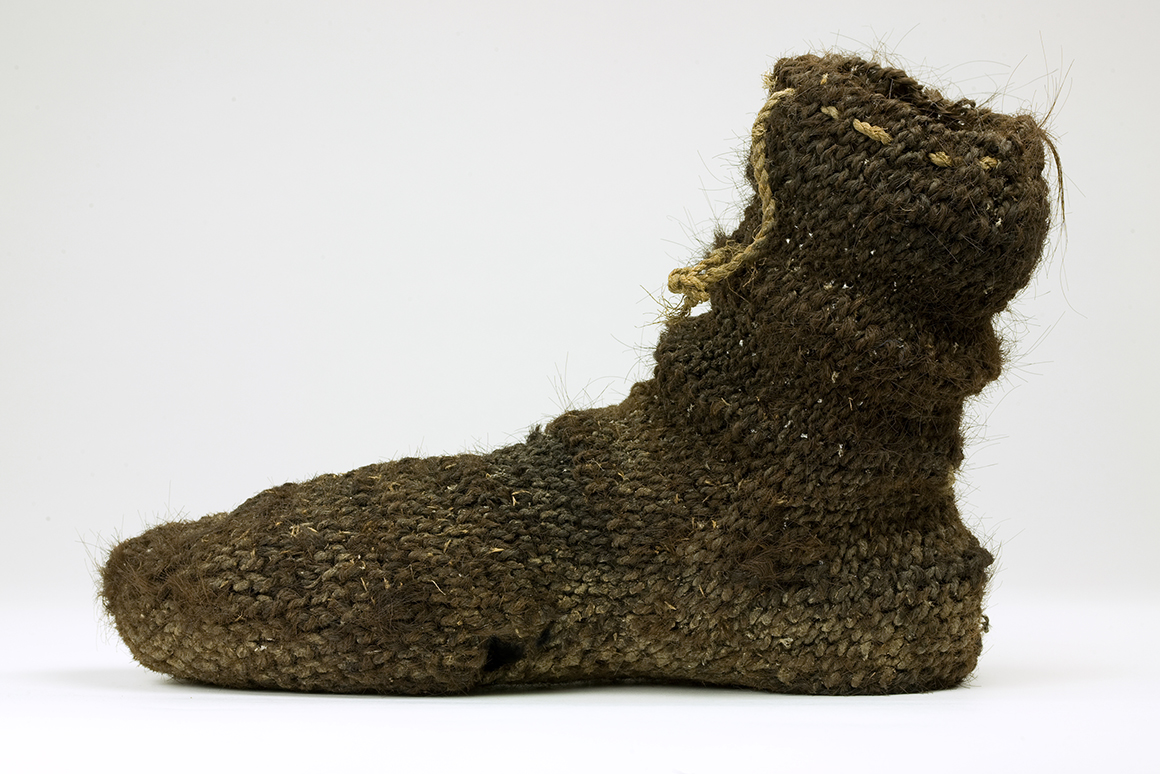 Ancestral Puebloan, c. 1200 The Ancestral Puebloans flourished in the 13th century in what is now the Southwestern United States. These ancestors of the Pueblo left behind fascinating architecture and remnants of their rich material culture, including footwear. Regarded as exceptional artisans, the Ancestral Puebloans often used human hair, one of the most accessible and renewable fibres, to craft things such as nets and socks. This sock, which dates to the 13th century, was made by knotting strands of hair and may have been worn alone or with a sandal. How long would you have to grow your hair in order to make a pair of socks from the strands? Collection of the Bata Shoe Museum, P89.231 Next Back
Ancestral Puebloan, c. 1200 The Ancestral Puebloans flourished in the 13th century in what is now the Southwestern United States. These ancestors of the Pueblo left behind fascinating architecture and remnants of their rich material culture, including footwear. Regarded as exceptional artisans, the Ancestral Puebloans often used human hair, one of the most accessible and renewable fibres, to craft things such as nets and socks. This sock, which dates to the 13th century, was made by knotting strands of hair and may have been worn alone or with a sandal. How long would you have to grow your hair in order to make a pair of socks from the strands? Collection of the Bata Shoe Museum, P89.231 Next Back  Yup'ik, 19th century Yup'ik women on the coast of Alaska traditionally made socks of woven grass for their husbands to wear in their hunting boots. Grass socks allowed the men's feet to stay warm and dry in the wet and cold Alaskan environment. How these socks were woven was regional and quickly identified where the maker was from. Collection of the Bata Shoe Museum, P01.68 Next Back
Yup'ik, 19th century Yup'ik women on the coast of Alaska traditionally made socks of woven grass for their husbands to wear in their hunting boots. Grass socks allowed the men's feet to stay warm and dry in the wet and cold Alaskan environment. How these socks were woven was regional and quickly identified where the maker was from. Collection of the Bata Shoe Museum, P01.68 Next Back 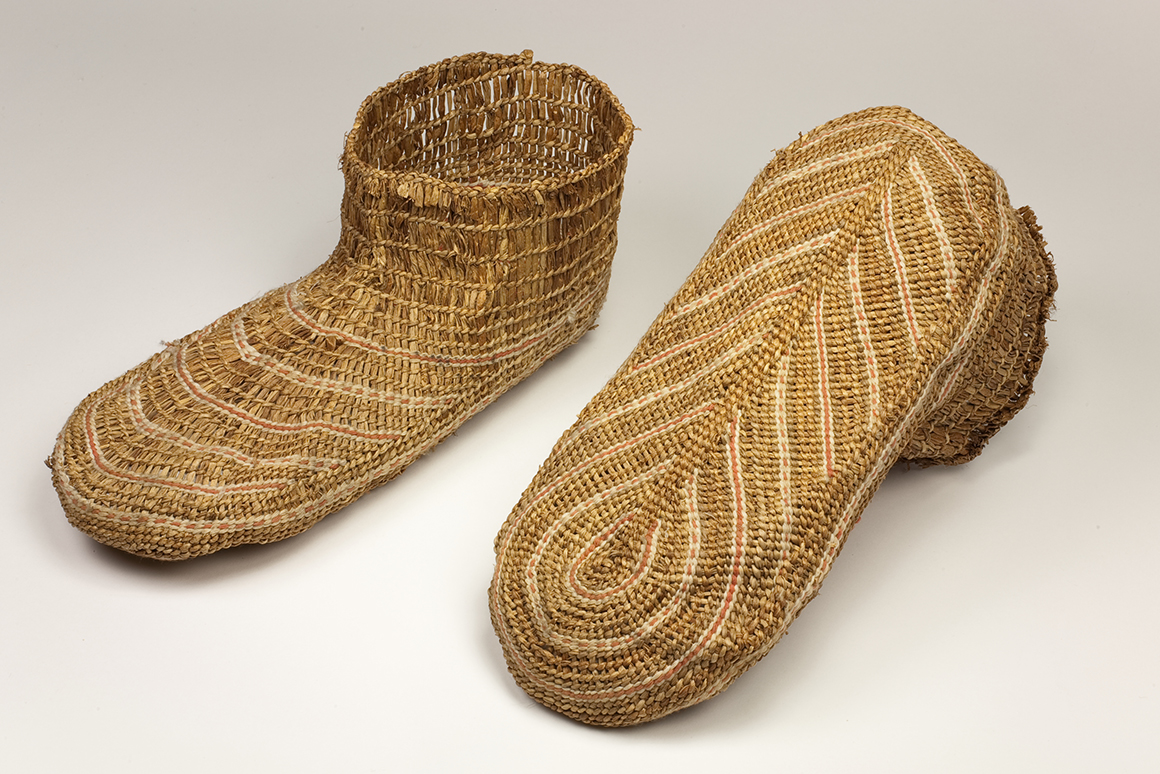
 Persian, Late 19th and early 20th century
Persian, Late 19th and early 20th century
The exact origins of knitting are unknown but it is thought that knitting first developed somewhere in the Near or Middle East – possibly in Iran. Traditionally some of the most intricately knit socks, such as these examples here, come from this region where cold weather makes socks a necessity. Collection of the Bata Shoe Museum, P87.100, P83.232 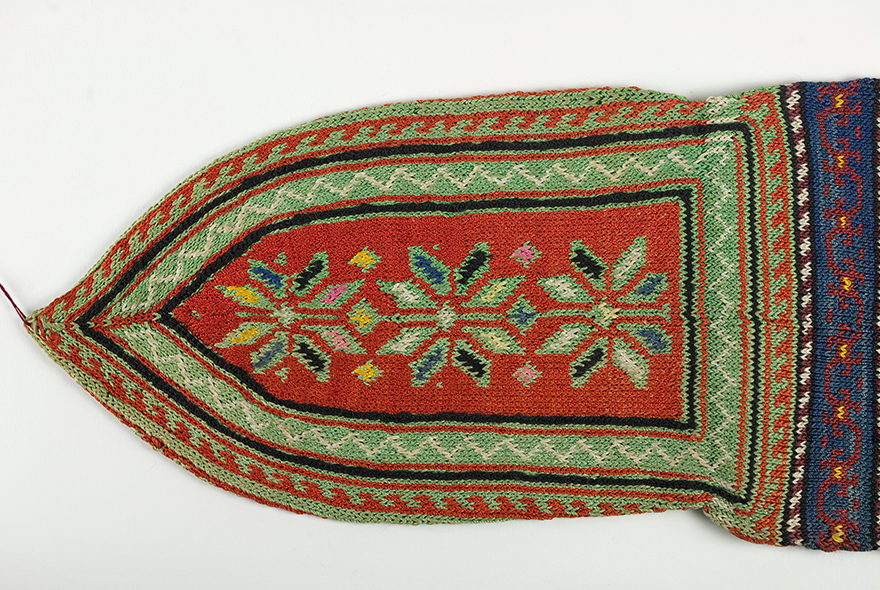
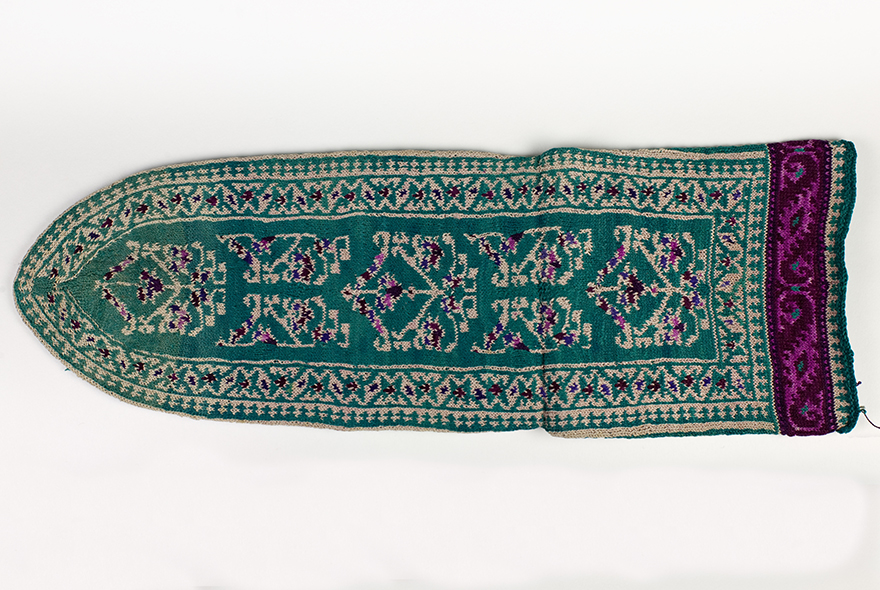 Back Next
Back Next 
 Possibly Spanish, 17th century Knitting was introduced into Europe by the Moors who ruled Spain from the 8th to the 15th centuries. Finely knit silk stockings became a highly desirable Spanish speciality. England's Queen Elizabeth I was said to have declared that she would never again wear linen hose after trying on a pair of Spanish silk stockings. This pair of hand-knit silk stockings is probably Spanish and was made for a very wealthy child. The stockings were made using silk threads that had been dyed red, which was the most expensive dye in the 17th century. The use of silver and gold gilt thread also suggests that the wearer was wealthy. Hover to see a close-up of the thread. Collection of the Bata Shoe Museum, P96.101 Next Back
Possibly Spanish, 17th century Knitting was introduced into Europe by the Moors who ruled Spain from the 8th to the 15th centuries. Finely knit silk stockings became a highly desirable Spanish speciality. England's Queen Elizabeth I was said to have declared that she would never again wear linen hose after trying on a pair of Spanish silk stockings. This pair of hand-knit silk stockings is probably Spanish and was made for a very wealthy child. The stockings were made using silk threads that had been dyed red, which was the most expensive dye in the 17th century. The use of silver and gold gilt thread also suggests that the wearer was wealthy. Hover to see a close-up of the thread. Collection of the Bata Shoe Museum, P96.101 Next Back 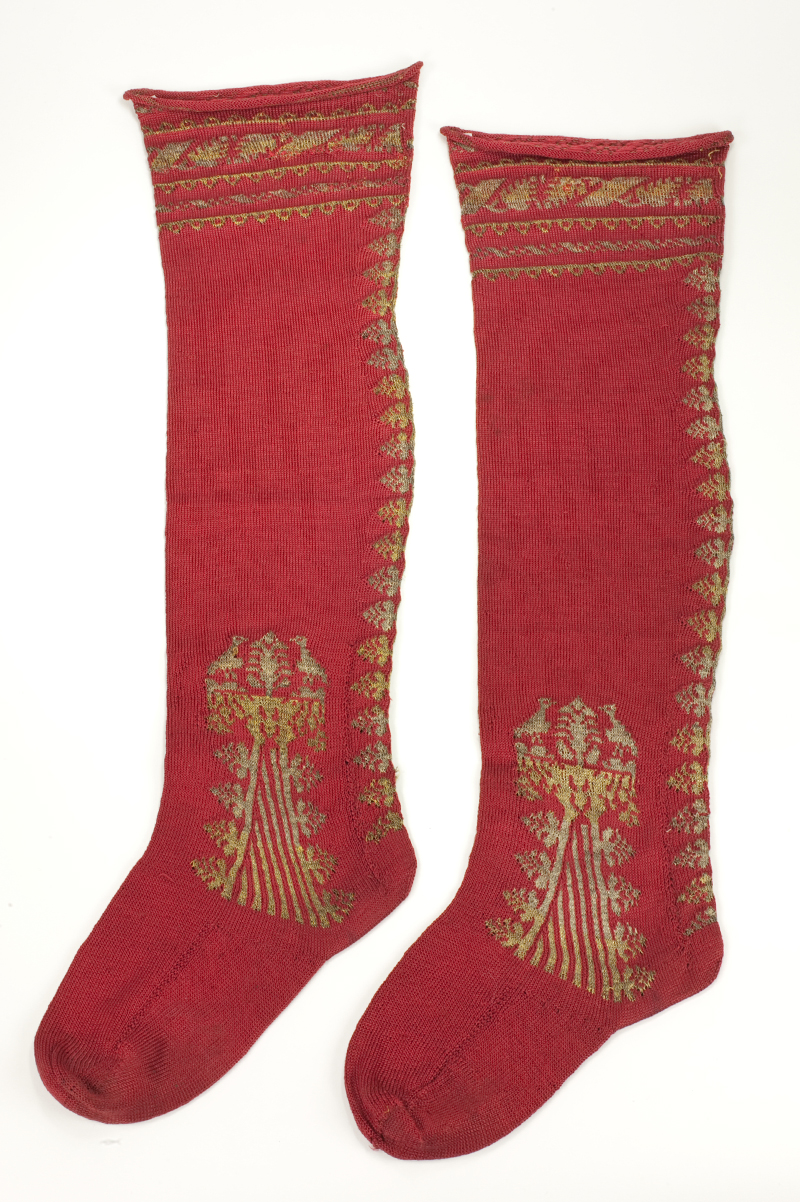
 English, 1630-40 This linen sock is really a boot hose. Boot hose were a protective layer that one would wear over expensive silk socks in order to protect them from abrasion by leather boots. Think of them as socks for your socks! Collection of the Bata Shoe Museum, P06.1 Next Back
English, 1630-40 This linen sock is really a boot hose. Boot hose were a protective layer that one would wear over expensive silk socks in order to protect them from abrasion by leather boots. Think of them as socks for your socks! Collection of the Bata Shoe Museum, P06.1 Next Back 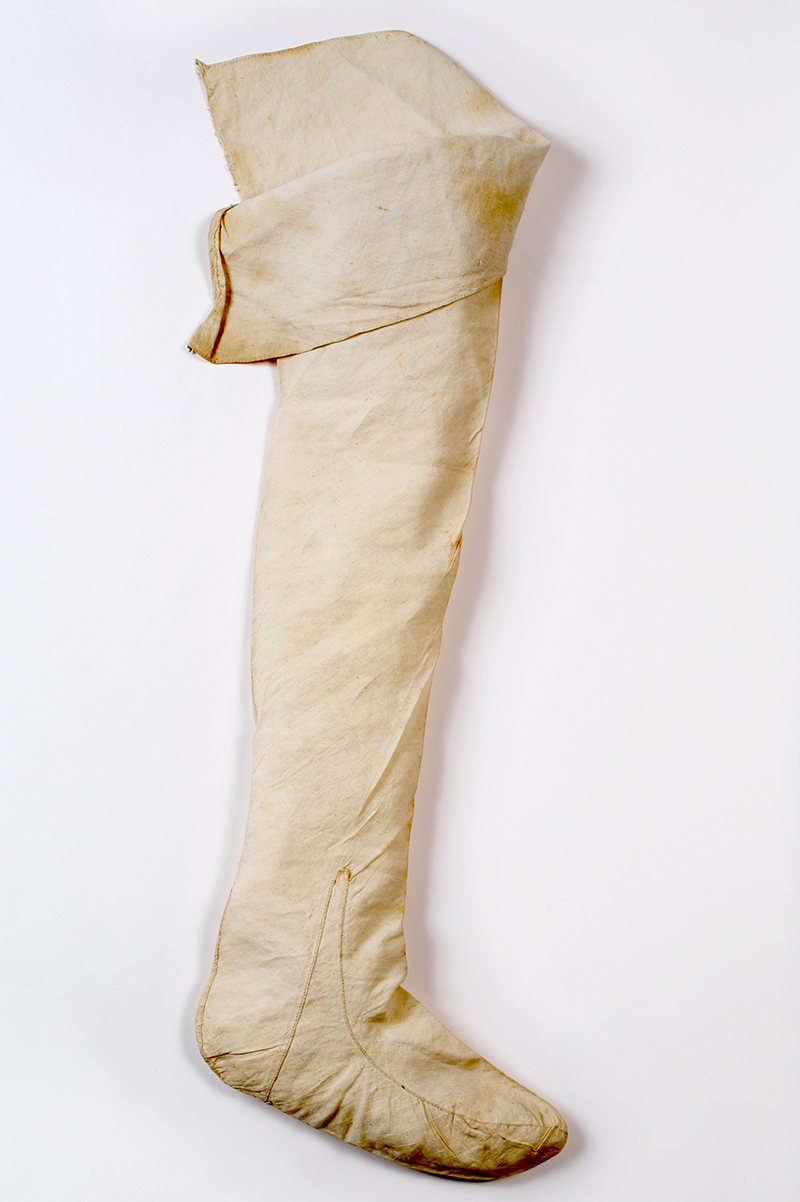

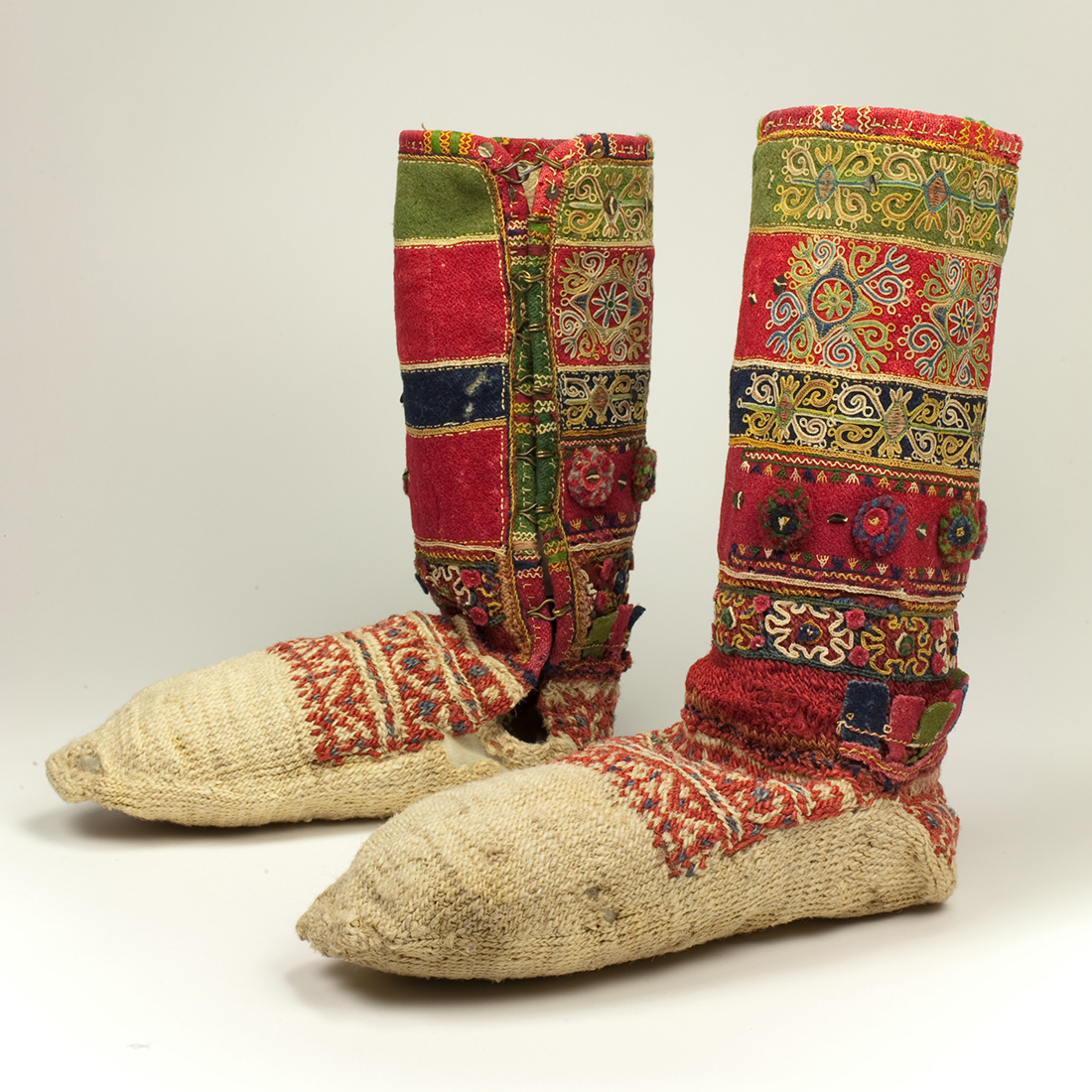 Croatian, 19th century Historically, sock knitting was a highly valued female skill in many Balkan countries and beautifully made socks were an important element of regional dress. This pair of Croatian men's socks from Grlici is a perfect example of just how splendid socks could be. The part of the sock that covers the foot is hand-knit, and the "leg part', called the shaft, is made of heavy wool fabric that has been covered with intricate embroidery as well as metal and fabric sequins. These socks would have been worn with knee length pants that allowed the decorative shafts to be seen. Collection of the Bata Shoe Museum, P94.54 Next Back
Croatian, 19th century Historically, sock knitting was a highly valued female skill in many Balkan countries and beautifully made socks were an important element of regional dress. This pair of Croatian men's socks from Grlici is a perfect example of just how splendid socks could be. The part of the sock that covers the foot is hand-knit, and the "leg part', called the shaft, is made of heavy wool fabric that has been covered with intricate embroidery as well as metal and fabric sequins. These socks would have been worn with knee length pants that allowed the decorative shafts to be seen. Collection of the Bata Shoe Museum, P94.54 Next Back  Metohija, early 20th century This hand-knit pair of traditional women's ankle-length socks comes from the Metohija region of Kosovo. The black wool used to knit these socks is the perfect backdrop for the metallic embroidery and red yarn used at the toe. Red and gold are colours commonly found in Metohija women's fashion. These socks would have been worn with a pair of leather opanke similar to the pair on view here. Collection of the Bata Shoe Museum, S84.207, P92.142
Metohija, early 20th century This hand-knit pair of traditional women's ankle-length socks comes from the Metohija region of Kosovo. The black wool used to knit these socks is the perfect backdrop for the metallic embroidery and red yarn used at the toe. Red and gold are colours commonly found in Metohija women's fashion. These socks would have been worn with a pair of leather opanke similar to the pair on view here. Collection of the Bata Shoe Museum, S84.207, P92.142
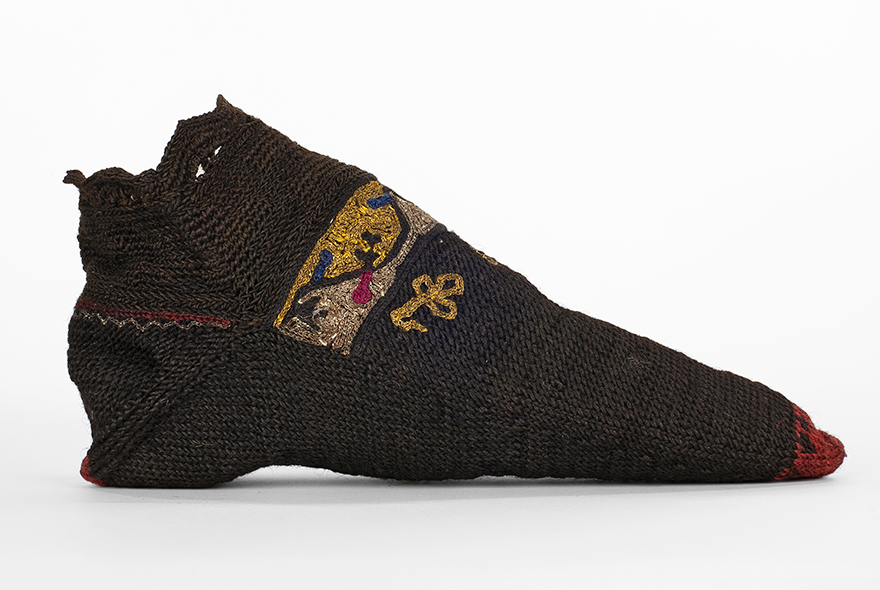
 Back Next
Back Next  Sjösamer, 1990-1995 Many Saami across Northern Europe traditionally use a layer of grass between themselves and their boots to insulate their feet and wick moisture away. Thick and warm socks might also be added for extra warmth. This pair of woolly socks was hand-knit from hand-spun wool by Sjösamer maker Kristen Losoa. After knitting the socks, Losoa washed them in hot water so that they shrank and became partially felted. Losoa made this pair of socks specifically for this pair of boots which she also made. Hover to see the matching boots. Collection of the Bata Shoe Museum, P00.79 Next Back
Sjösamer, 1990-1995 Many Saami across Northern Europe traditionally use a layer of grass between themselves and their boots to insulate their feet and wick moisture away. Thick and warm socks might also be added for extra warmth. This pair of woolly socks was hand-knit from hand-spun wool by Sjösamer maker Kristen Losoa. After knitting the socks, Losoa washed them in hot water so that they shrank and became partially felted. Losoa made this pair of socks specifically for this pair of boots which she also made. Hover to see the matching boots. Collection of the Bata Shoe Museum, P00.79 Next Back 
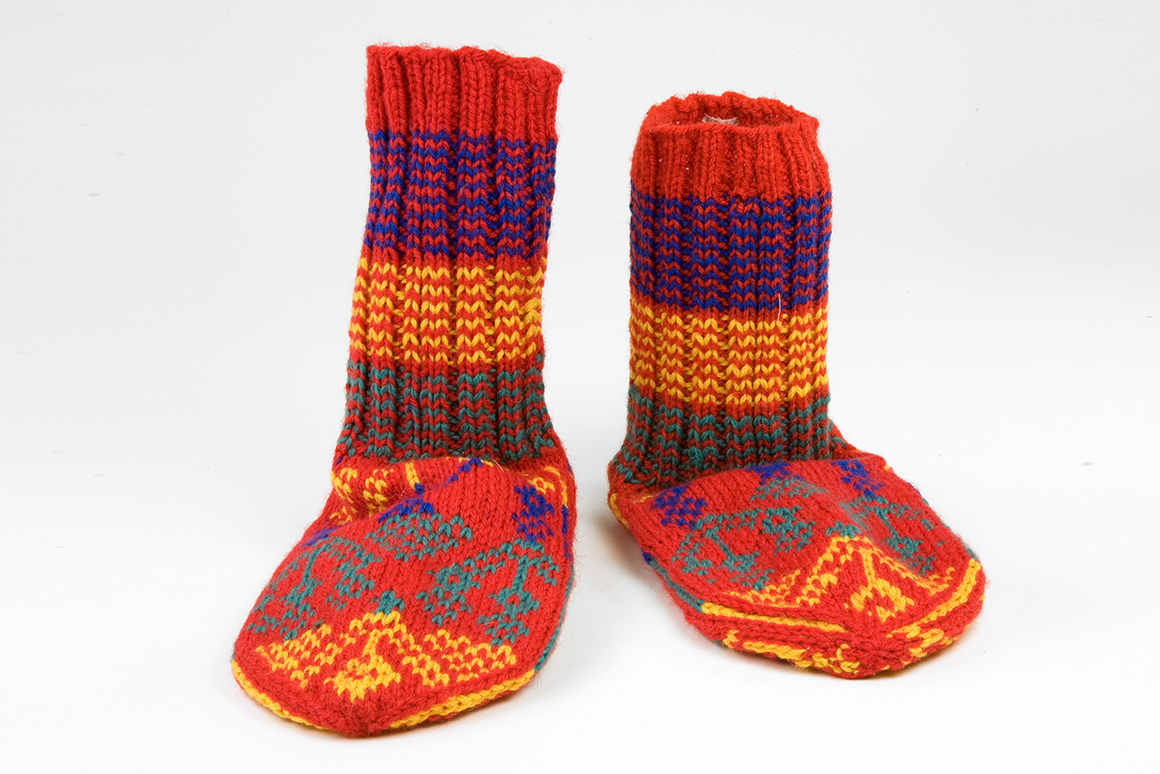

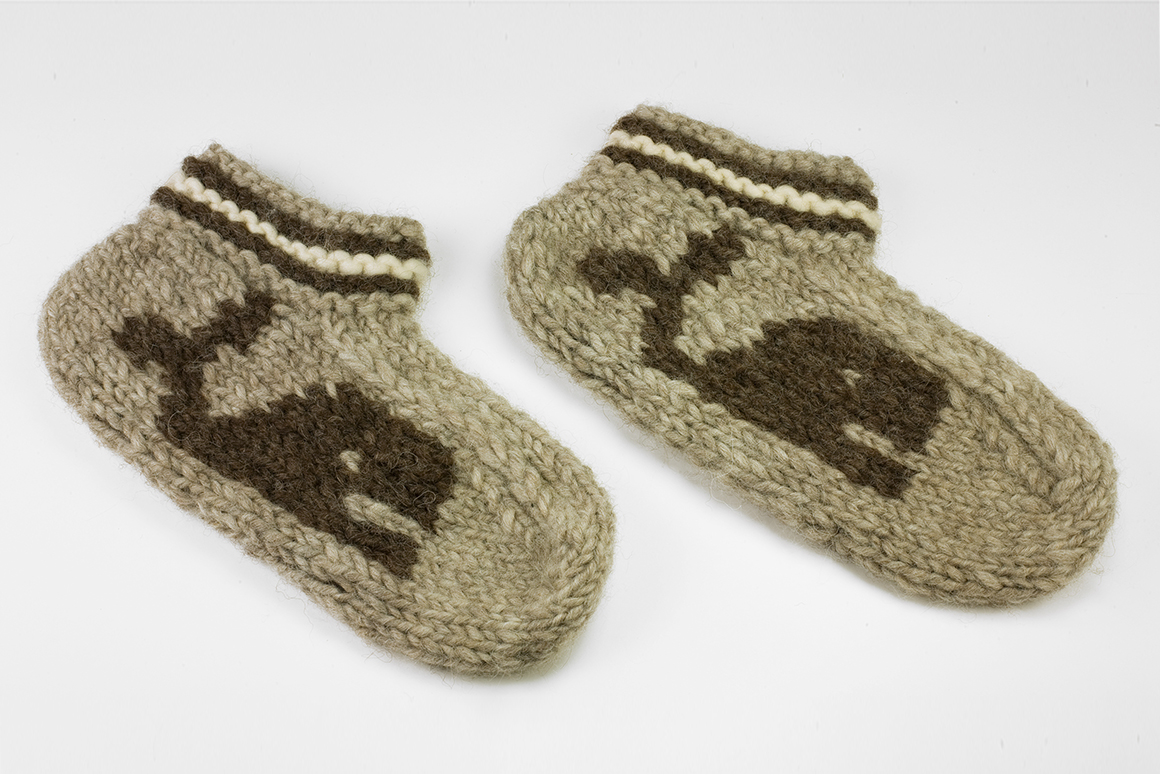 Northwest Salish, 1970s Sheep were first brought to Canada in the 1650s by French settlers. By the 1850s, they were introduced to the West Coast of Canada and by the 1860's, Indigenous Salish communities had adopted knitting. By the early 20th century they developed a unique style of patterns using motifs such as the whale seen on this pair of socks. By the 1920's, Salish knitting was well established and by the 1940s their knitted garments were in high demand. Collection of the Bata Shoe Museum, S83.269 Next Back
Northwest Salish, 1970s Sheep were first brought to Canada in the 1650s by French settlers. By the 1850s, they were introduced to the West Coast of Canada and by the 1860's, Indigenous Salish communities had adopted knitting. By the early 20th century they developed a unique style of patterns using motifs such as the whale seen on this pair of socks. By the 1920's, Salish knitting was well established and by the 1940s their knitted garments were in high demand. Collection of the Bata Shoe Museum, S83.269 Next Back 
 Iglulingmiut Inuit, 1987 Traditional Inuit fashion includes cosy wool boot liners and slippers that are often worn inside kamiks. Historically, the Inuit made boot liners exclusively out of hide with the hair side against one's skin for warmth, but more recently, wool fabric and duffle have become popular materials. Rather than being knit, however, wool duffels are sewn together. Many seamstresses embellish the tops of boot liners with embroidery. This pair of boots and liners was made by Iglulingmiut Inuit seamstress Leah Okadluk. Collection of the Bata Shoe Museum, P87.87 Next Back
Iglulingmiut Inuit, 1987 Traditional Inuit fashion includes cosy wool boot liners and slippers that are often worn inside kamiks. Historically, the Inuit made boot liners exclusively out of hide with the hair side against one's skin for warmth, but more recently, wool fabric and duffle have become popular materials. Rather than being knit, however, wool duffels are sewn together. Many seamstresses embellish the tops of boot liners with embroidery. This pair of boots and liners was made by Iglulingmiut Inuit seamstress Leah Okadluk. Collection of the Bata Shoe Museum, P87.87 Next Back  Northern Afghanistan Leather boot socks such as this highly decorated pair from Northern Afghanistan were designed to be worn with a pair of shoes when outside. The knee-high leather sock combined with a shoe would function like a boot, and was often worn for horseback riding and walking. The shoes were removed when entering a home; leaving the soft-soled socks to be worn indoors. Collection of the Bata Shoe Museum, P82.141 Next Back
Northern Afghanistan Leather boot socks such as this highly decorated pair from Northern Afghanistan were designed to be worn with a pair of shoes when outside. The knee-high leather sock combined with a shoe would function like a boot, and was often worn for horseback riding and walking. The shoes were removed when entering a home; leaving the soft-soled socks to be worn indoors. Collection of the Bata Shoe Museum, P82.141 Next Back 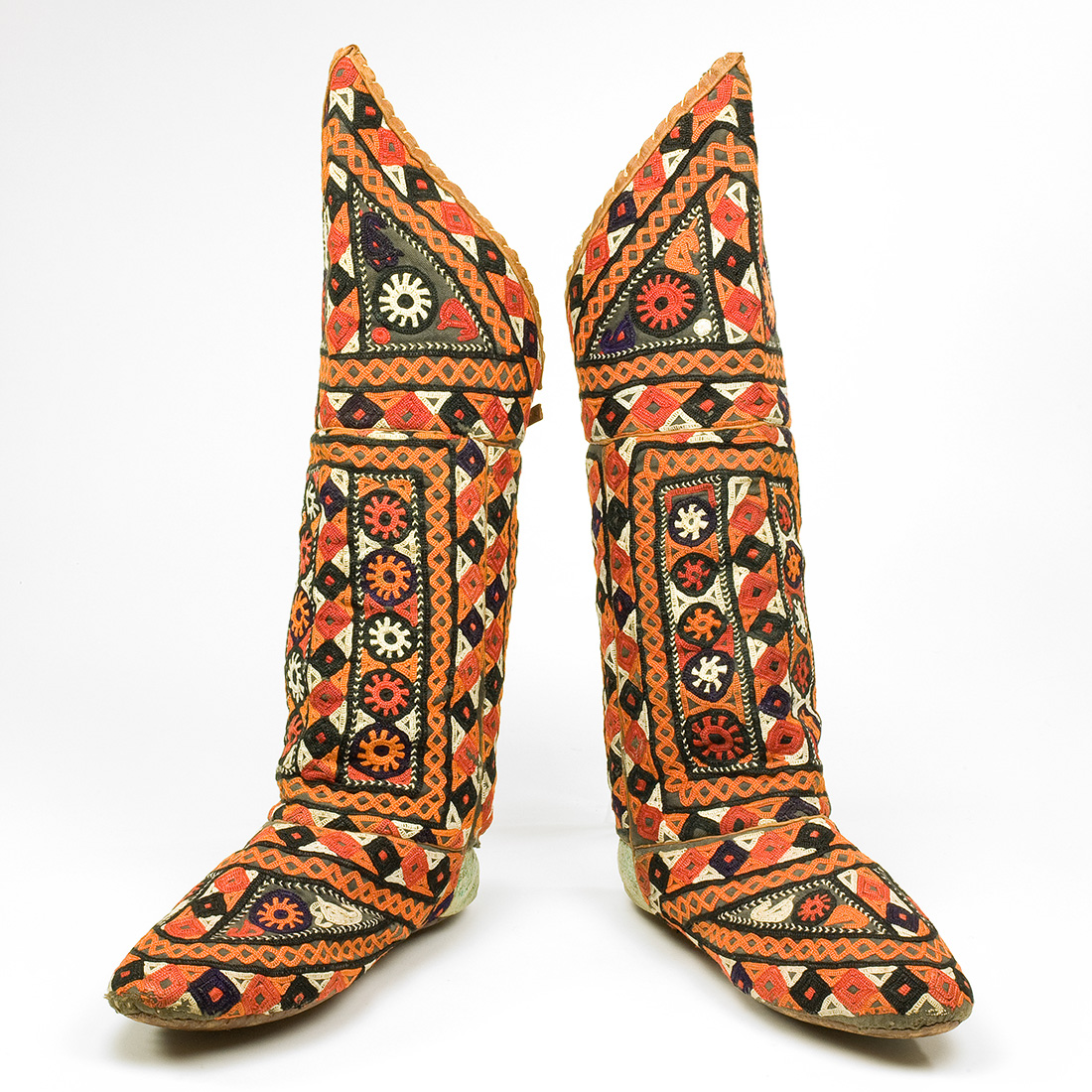
 Nanai, 1994
Nanai, 1994
The Nanai from the Amur region in the Far East traditionally wore waterproof fish skin boots with decorative sock inserts in the winter. This pair, made by Ann Michailovna Beldi of Sakhalin Island, was quilted to provide warmth. The upper part of the shaft was heavily decorated with textile appliqué that reflects Chinese cultural influence. Collection of the Bata Shoe Museum, P95.137 Next Back 

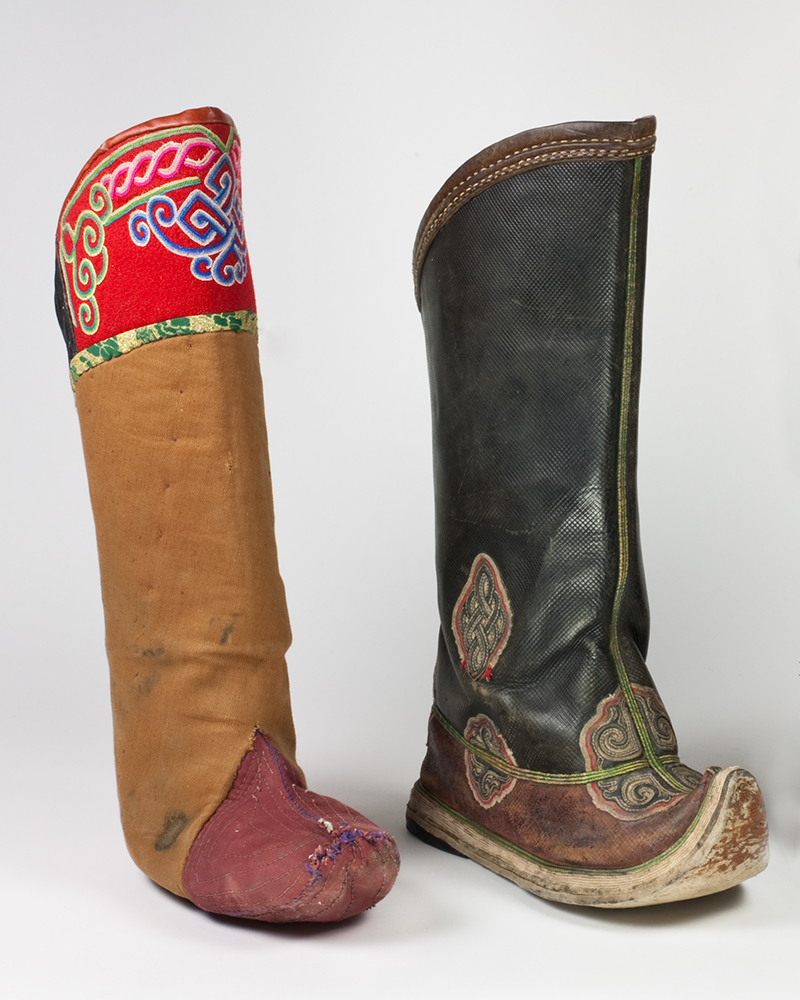 Mongolian, 1965-75 The maker of these Mongolian boot liners embellished the bright red cuff with colourful embroidery which was designed to be seen above the top line of the boot. The rest of the sock was quilted for warmth and designed to fit snugly. These were made for an aristocratic woman, and are made of cotton. Collection of the Bata Shoe Museum, P05.31 Next Back
Mongolian, 1965-75 The maker of these Mongolian boot liners embellished the bright red cuff with colourful embroidery which was designed to be seen above the top line of the boot. The rest of the sock was quilted for warmth and designed to fit snugly. These were made for an aristocratic woman, and are made of cotton. Collection of the Bata Shoe Museum, P05.31 Next Back  Uzbeck or Kazakh, 19th century The inlaid leather work on this pair of Uzbeck or Kazakh boot socks is a wonderful example of the highly decorative leather work that was historically produced in this part of the world. Like the Afghan boot sock, these could be worn alone indoors, or with a shoe when outdoors. Collection of the Bata Shoe Museum, S00.110 Next Back
Uzbeck or Kazakh, 19th century The inlaid leather work on this pair of Uzbeck or Kazakh boot socks is a wonderful example of the highly decorative leather work that was historically produced in this part of the world. Like the Afghan boot sock, these could be worn alone indoors, or with a shoe when outdoors. Collection of the Bata Shoe Museum, S00.110 Next Back 

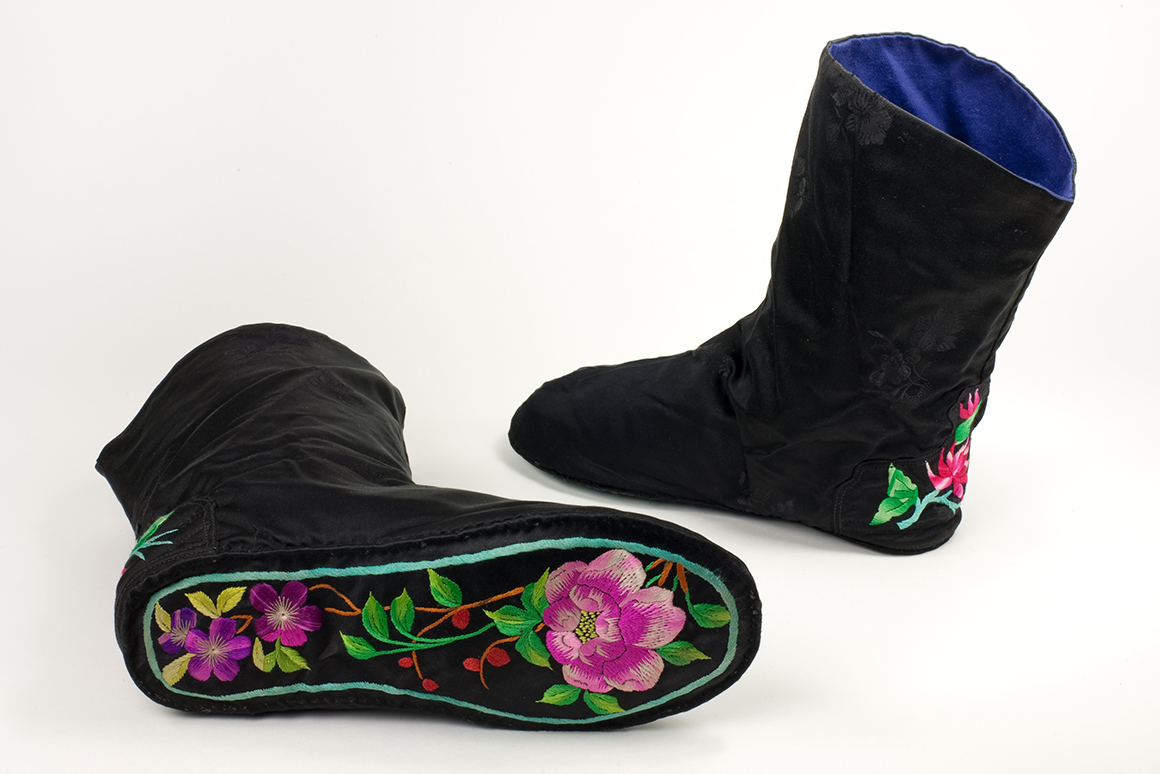 Sala, 1954-1955 Salar communities originated in Samarkand in Southeastern Uzbekistan, but moved eastward into China in the 14th century. These socks reflect the blending of Chinese and Central Asian cultures in style and function. Zhao Ga Mei made these socks with embroidered soles to be worn at home. The style of these silk brocade socks is very Chinese as is the very fine floral embroidery done in silk floss that embellishes them. Collection of the Bata Shoe Museum, P95.137 Next Back
Sala, 1954-1955 Salar communities originated in Samarkand in Southeastern Uzbekistan, but moved eastward into China in the 14th century. These socks reflect the blending of Chinese and Central Asian cultures in style and function. Zhao Ga Mei made these socks with embroidered soles to be worn at home. The style of these silk brocade socks is very Chinese as is the very fine floral embroidery done in silk floss that embellishes them. Collection of the Bata Shoe Museum, P95.137 Next Back  Manchu, c. 1880 Traditionally, Chinese mothers and grandmothers lavished the garments they made for their family members with embroidery, including socks. This adorable pair of children's socks was embroidered with depictions of flowers, birds and bugs; there is even a tiny embroidered toad hidden in the reeds. What other shapes and animals can you see on these socks? Collection of the Bata Shoe Museum, P96.105 Next Back
Manchu, c. 1880 Traditionally, Chinese mothers and grandmothers lavished the garments they made for their family members with embroidery, including socks. This adorable pair of children's socks was embroidered with depictions of flowers, birds and bugs; there is even a tiny embroidered toad hidden in the reeds. What other shapes and animals can you see on these socks? Collection of the Bata Shoe Museum, P96.105 Next Back 

 Korean, 19th and 20th centuries Historically in Korea, textile work was a prized female skill, and sock-making was one of the many responsibilities of a wife. Women made patterns for each of their family members out of delicate rice paper and then kept these patterns neatly folded in little brocade envelopes. An egg-shaped heel was considered to be a hallmark of beauty in Korea and the design of Korean socks reflects this ideal. Hover to see the rice paper pattern. Collection of the Bata Shoe Museum, P81.335, S83.98 Next Back
Korean, 19th and 20th centuries Historically in Korea, textile work was a prized female skill, and sock-making was one of the many responsibilities of a wife. Women made patterns for each of their family members out of delicate rice paper and then kept these patterns neatly folded in little brocade envelopes. An egg-shaped heel was considered to be a hallmark of beauty in Korea and the design of Korean socks reflects this ideal. Hover to see the rice paper pattern. Collection of the Bata Shoe Museum, P81.335, S83.98 Next Back 
 Japanese, 20th century Japanese socks, called tabi, are typically made of crisp white cotton that is sewn into a foot shape and feature a bifurcated toe to accommodate the thongs of the zori and geta. They closed around the foot with metal tabs at the back of the heel. Tabi are an essential part of traditional Japanese dress and are appropriate for formal wear. They are also essential culturally; in Japan shoes are never worn indoors, instead they are removed before entering a home and tabi can worn around the house. Collection of the Bata Shoe Museum, S82.76, S79.76 Next Back
Japanese, 20th century Japanese socks, called tabi, are typically made of crisp white cotton that is sewn into a foot shape and feature a bifurcated toe to accommodate the thongs of the zori and geta. They closed around the foot with metal tabs at the back of the heel. Tabi are an essential part of traditional Japanese dress and are appropriate for formal wear. They are also essential culturally; in Japan shoes are never worn indoors, instead they are removed before entering a home and tabi can worn around the house. Collection of the Bata Shoe Museum, S82.76, S79.76 Next Back 

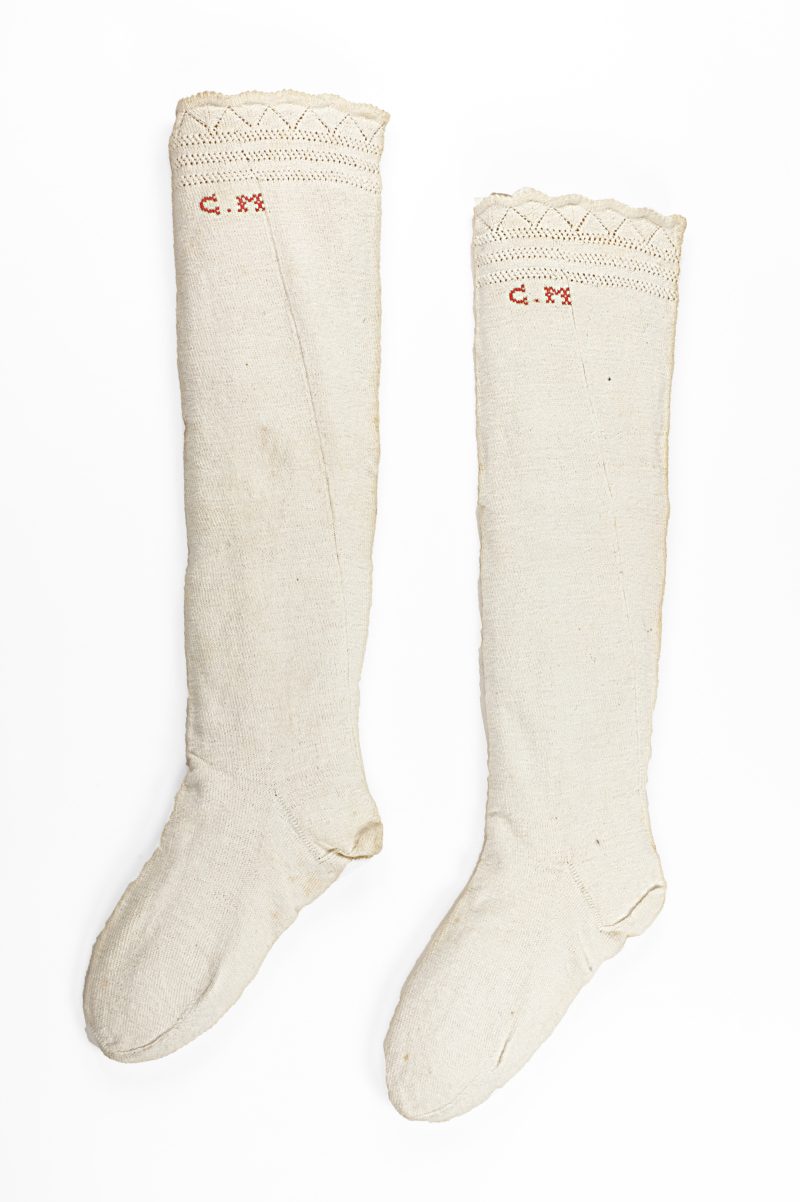 American, 19th century The invention of the stocking frame in the late 16th century marked the beginning of manufactured hosiery which meant using machinery to produce socks and stockings on a large scale. By the 19th century, most knit socks and stockings were being made on circular sock knitting machines like this example. Most manufactured socks were plain and utilitarian but some were quite decorative. The design at the top of this pair adds a bit of flair to these rather humble hose. Their owner personalized them by embroidering her initials "C.M." at the top. Collection of Marg Meikle and Collection of the Bata Shoe Museum, S86.174 Next Back
American, 19th century The invention of the stocking frame in the late 16th century marked the beginning of manufactured hosiery which meant using machinery to produce socks and stockings on a large scale. By the 19th century, most knit socks and stockings were being made on circular sock knitting machines like this example. Most manufactured socks were plain and utilitarian but some were quite decorative. The design at the top of this pair adds a bit of flair to these rather humble hose. Their owner personalized them by embroidering her initials "C.M." at the top. Collection of Marg Meikle and Collection of the Bata Shoe Museum, S86.174 Next Back  American, early 20th century Shoe fashions can sometimes reflect a larger social change that is on the horizon. For example, women's style changed dramatically in the 1920s when skirts became shorter and sandals became popular, showing more of a women's legs and feet than ever before. These boots from earlier in the 20th century feature cut-outs and signal how fashions gradually began to shift to be less cumbersome and show more and more skin. This pair was designed so that the stockings worn inside them could be seen through the cut-outs. Collection of the Bata Shoe Museum, S91.20 P91.3
American, early 20th century Shoe fashions can sometimes reflect a larger social change that is on the horizon. For example, women's style changed dramatically in the 1920s when skirts became shorter and sandals became popular, showing more of a women's legs and feet than ever before. These boots from earlier in the 20th century feature cut-outs and signal how fashions gradually began to shift to be less cumbersome and show more and more skin. This pair was designed so that the stockings worn inside them could be seen through the cut-outs. Collection of the Bata Shoe Museum, S91.20 P91.3
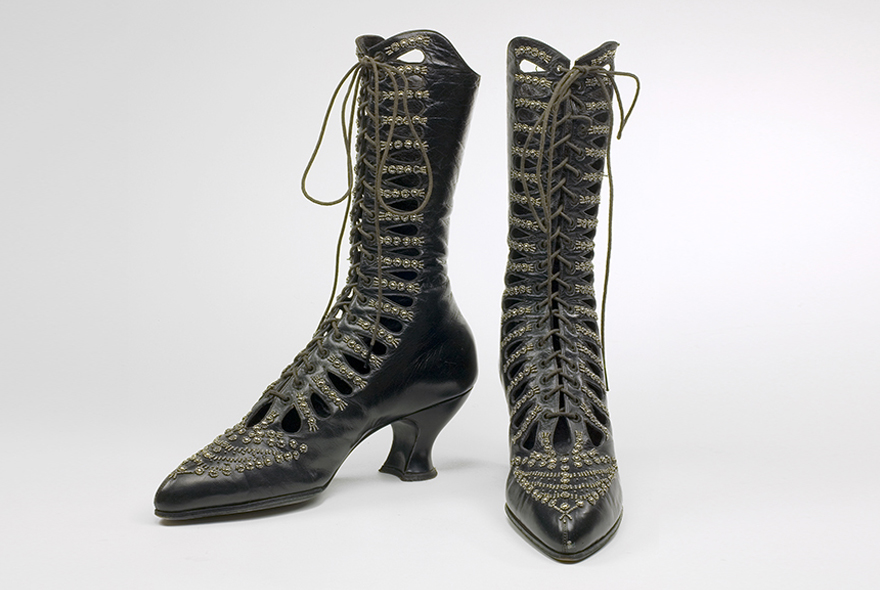
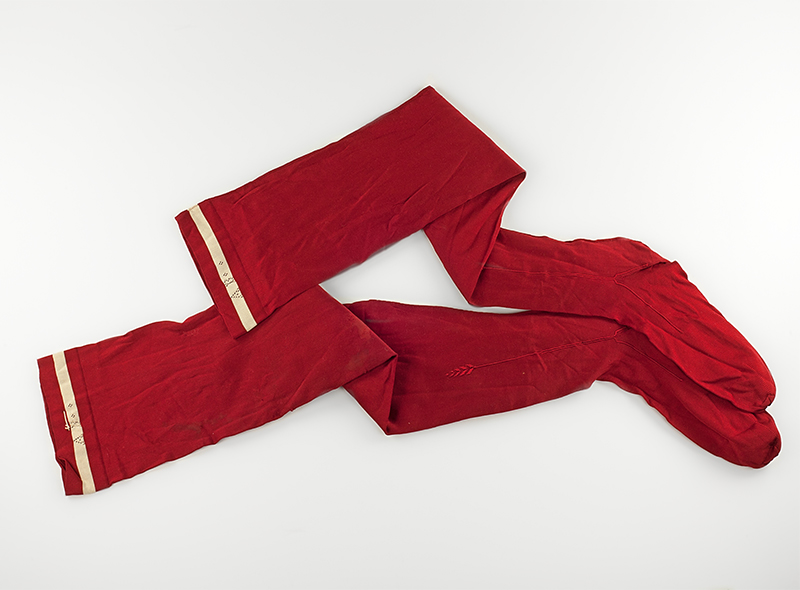 Back Next
Back Next  American and Canadian, 1950s Bobby socks became popular during WWII when rationing in England and North America made nylons unavailable. In England, women began wearing ankle socks with their shoes but in North America, the trend was embraced by teenage girls who called them "bobby socks" after British policeman. Typically worn with saddle shoes, white wool bobby socks became a teen fashion craze. Dances called "sock hops" where kids danced in their socks to rock-and-roll music helped to define an era. Collection of the Bata Shoe Museum, S10.2, S06.23
American and Canadian, 1950s Bobby socks became popular during WWII when rationing in England and North America made nylons unavailable. In England, women began wearing ankle socks with their shoes but in North America, the trend was embraced by teenage girls who called them "bobby socks" after British policeman. Typically worn with saddle shoes, white wool bobby socks became a teen fashion craze. Dances called "sock hops" where kids danced in their socks to rock-and-roll music helped to define an era. Collection of the Bata Shoe Museum, S10.2, S06.23 
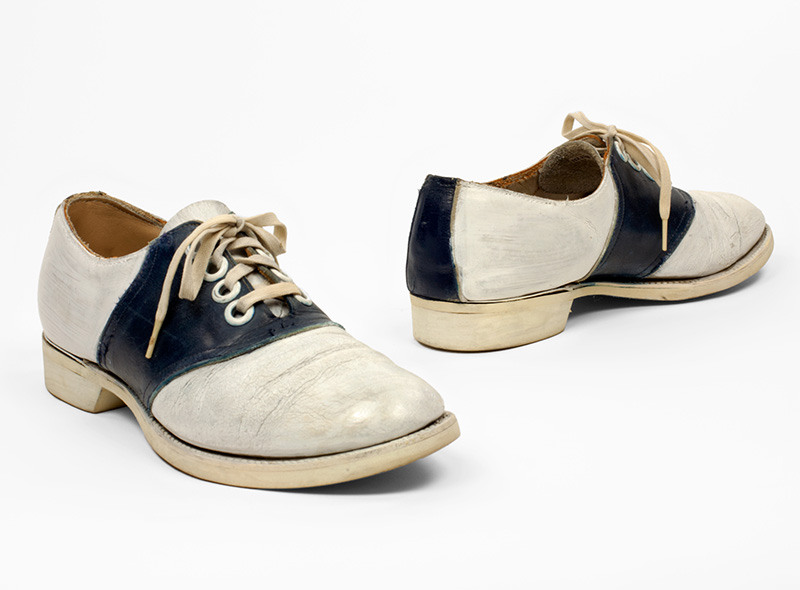 Back Next
Back Next  French and American, mid-1960s Bright colours defined much of 1960s fashion; subtle elegance was out and daring design was in. Hemlines became very short and young women took to wearing bold coloured stockings. This pair of apple green stockings was designed by famed Italian fashion designer Elsa Schiaparelli. They would have gone well with this pair of witty "car" shoes designed by American shoe designer, Beth Levine. Collection of the Bata Shoe Museum, P96.162, P93.57
French and American, mid-1960s Bright colours defined much of 1960s fashion; subtle elegance was out and daring design was in. Hemlines became very short and young women took to wearing bold coloured stockings. This pair of apple green stockings was designed by famed Italian fashion designer Elsa Schiaparelli. They would have gone well with this pair of witty "car" shoes designed by American shoe designer, Beth Levine. Collection of the Bata Shoe Museum, P96.162, P93.57 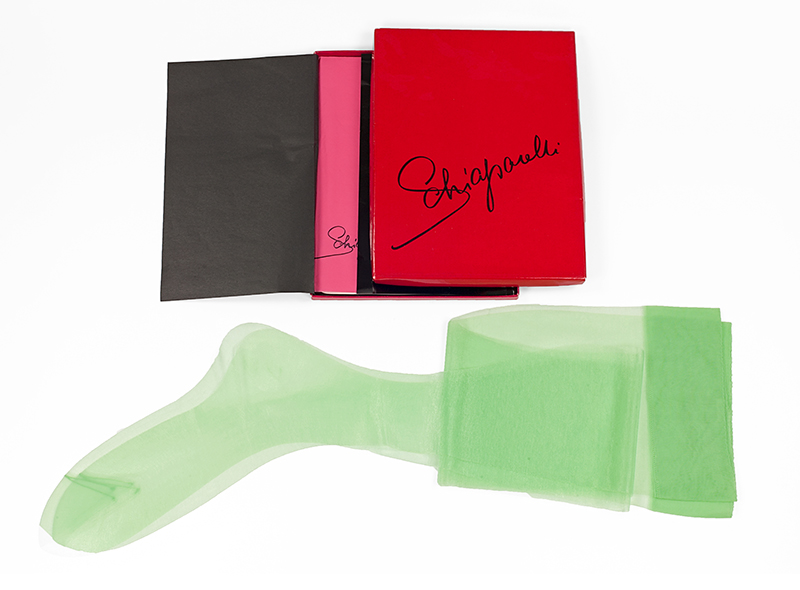
 Back Next
Back Next 
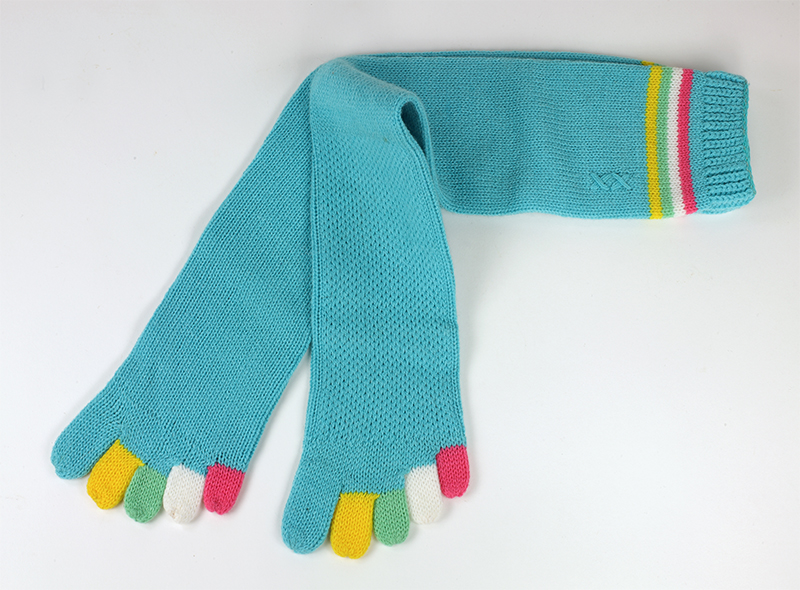 American, mid-1970s Toe socks became a teen fashion craze in the mid-1970s; made like gloves for the feet, toe socks separated each toe. Some girls even wore them with sandals so that their toes could be seen. Collection of the Bata Shoe Museum, S10.3 Next Back
American, mid-1970s Toe socks became a teen fashion craze in the mid-1970s; made like gloves for the feet, toe socks separated each toe. Some girls even wore them with sandals so that their toes could be seen. Collection of the Bata Shoe Museum, S10.3 Next Back  Back Next Through history, people have held on to socks that have belonged to
Back Next Through history, people have held on to socks that have belonged to
famous people? Are socks something that you would want to collect?  French, c. 1820-21 This pair of socks was worn by French military and political leader Napoleon Bonaparte when he was living in exile on St. Helena. They came from the family of W. Dickson, the assistant surgeon on H.M.S. Camel, the ship which carried Napoleon's belongings and entourage from St. Helena back to France after Napoleon's death. Hover to reveal Napoleans socks. Collection of the Bata Shoe Museum, P96.75 Next Back
French, c. 1820-21 This pair of socks was worn by French military and political leader Napoleon Bonaparte when he was living in exile on St. Helena. They came from the family of W. Dickson, the assistant surgeon on H.M.S. Camel, the ship which carried Napoleon's belongings and entourage from St. Helena back to France after Napoleon's death. Hover to reveal Napoleans socks. Collection of the Bata Shoe Museum, P96.75 Next Back 


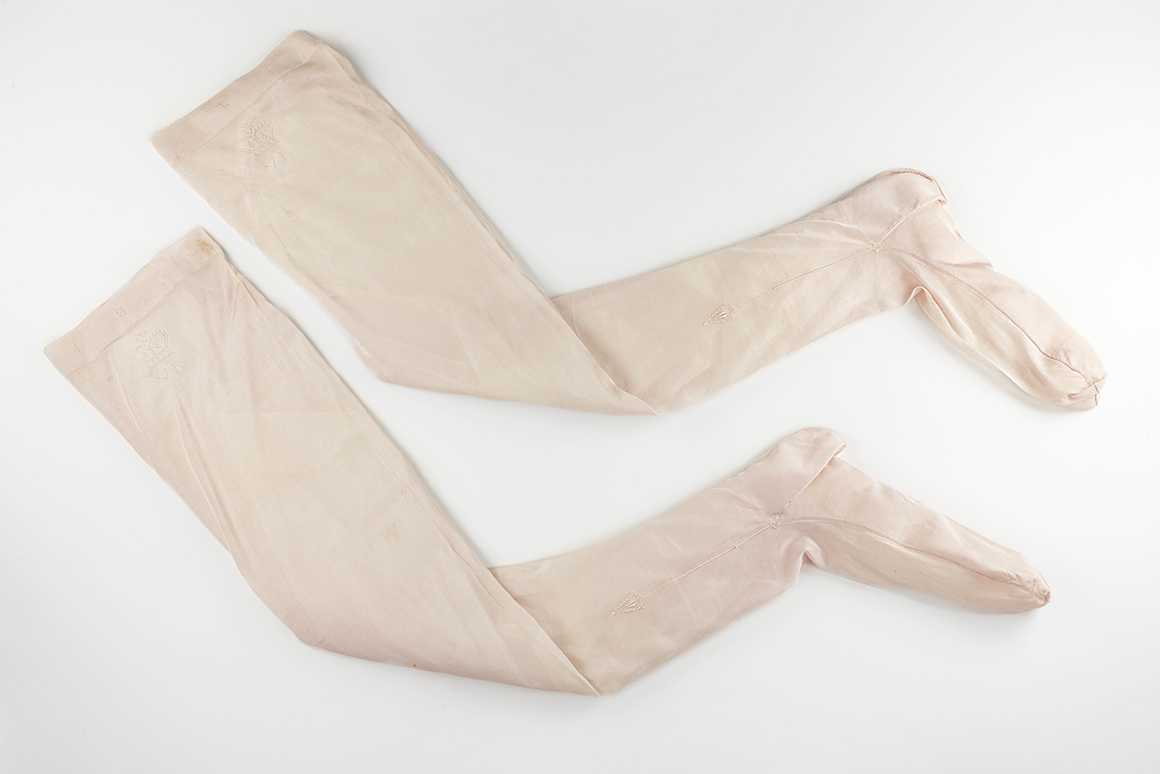 English, 1840-1860 Britain's Queen Victoria ruled from 1837 until 1901 and her personal style helped to shape Western fashion history. These silk stockings feature Queen Victoria's Imperial cypher "VR", meaning Victoria Regina, woven into the stockings under a crown near the top of the hosiery. Victoria famously wore mostly black after the death of her husband Albert in 1861. Given their pale pink colour, it is likely that these were worn by her before this time. Hover to reveal her stockings Collection of the Bata Shoe Museum, P85.94 Next Back
English, 1840-1860 Britain's Queen Victoria ruled from 1837 until 1901 and her personal style helped to shape Western fashion history. These silk stockings feature Queen Victoria's Imperial cypher "VR", meaning Victoria Regina, woven into the stockings under a crown near the top of the hosiery. Victoria famously wore mostly black after the death of her husband Albert in 1861. Given their pale pink colour, it is likely that these were worn by her before this time. Hover to reveal her stockings Collection of the Bata Shoe Museum, P85.94 Next Back 
 Back Next If you became famous, is there a special pair of socks that you would like to be remembered by?
Back Next If you became famous, is there a special pair of socks that you would like to be remembered by? 
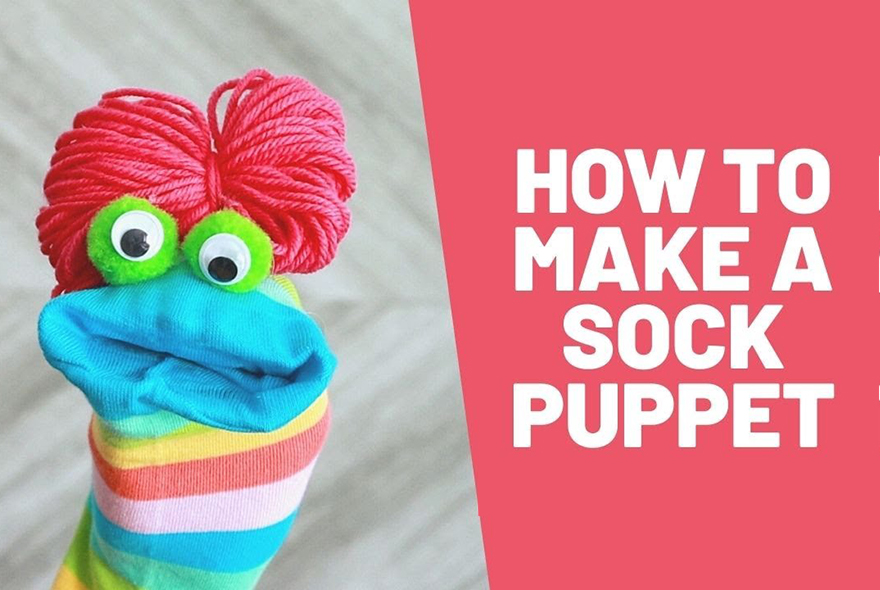 Get Creative Fun family activities, create a sock puppet, listen to our Storytime Series and more!
Get Creative Fun family activities, create a sock puppet, listen to our Storytime Series and more!  Shop Online Enjoy a special offer on our online shop and receive our colouring book, FREE! Follow us @batashoemuseum
Shop Online Enjoy a special offer on our online shop and receive our colouring book, FREE! Follow us @batashoemuseum  SOCKS: Between You and Your Shoes
SOCKS: Between You and Your Shoes
Toronto: Bata Shoe Museum Foundation, 2021 Curated by Elizabeth Semmelhack.
Original exhibition designed by: Leonard Wyma
All items from the collection of Bata Shoe Museum.
Copyright © 2021 Bata Shoe Museum, Toronto, Canada Back Restartreplay Fun Family Activities! Sermon Museum Memorial Childs Shoe Sock Carefully Folded
Source: https://batashoemuseum.ca/socks/




 Back
Back 





 Back
Back 






 Back
Back 























































 Back
Back 





 Back
Back 



0 Response to "Sermon Museum Memorial Childs Shoe Sock Carefully Folded"
Post a Comment